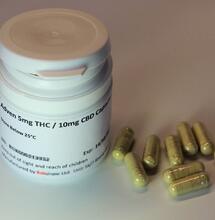Autoflower

By now I'm sure we have all heard or read the term ‘autoflower' somewhere, but what is it and what does it mean? Autoflower refers to a new type of crossbreed cannabis plant that is gaining popularity in seed banks everywhere.
By now I'm sure we have all heard or read the term ‘autoflower' somewhere, but what is it and what does it mean? Autoflower refers to a new type of crossbreed cannabis plant that is gaining popularity in seed banks everywhere.
By now I’m sure we have all heard or read the term ‘autoflower’ somewhere, but what is it and what does it mean? Autoflower refers to a new type of crossbreed cannabis plant that is gaining popularity in seed banks everywhere. We are all familiar with the two main sub-types of cannabis plants, indica and sativa.
Indica, which originated from areas like Southeast Asia (widely known in history for Indian hemp production) grows to be a short, bushy plant and has the largest yields per unit for a cannabis sub-species. Indica contains higher levels of CBD than it does of THC. (CBD) Cannabidiol is next in line from THC on the list of cannabinoids found in cannabis plants.
Sativa, originating in many different parts of the world (historically used for industrial fiber, oil, feed stuff etc.) and is the most widely cultivated type of cannabis plant. This sub-type grows tall and has few widely spaced branches, resulting in slightly less yield per plant in comparison. Sativa contains higher levels of THC than it does CBD.
| Big Devil XL |
The summer days in the parts of the world we find this sub-species can reach up to 24 hours of sunlight, so this plant had to develop the unusual ability to flower under any light condition just to survive. Making them very unique in that they are not phototropic like all other cannabis plants, meaning they do not rely on the light hours to tell them what season it is and what growth stage to be in. Ruderalis’ have a set life span, determined by age and automatically go into the flowering stage when they reach a certain stage of maturity, hence the name; Autoflower.
Before we go too far I want to go over some of the terminology used here for our purposes for those who don’t know. The genotype (or genes) is inherited, stored information to make and maintain a plant. These are genetic codes that are imbedded and carried by all plants (and by all living organisms for that matter) and they are passed on thru reproduction. The phenotypes represent different observable traits of a strain or crossbreed. Including anything that is part of the behaviors or functions of a living organism; such as THC content, density, leaf structure, flavor, height, bushiness etc. Example: You purchase a 10 pack of seeds that are a 50/50 indica x sativa cross. When you germinate these seeds chances are you will get a variety of phenotypes yet they will all be of the same genotype, containing the same genes, from having the same parents. Just another example of the proverbial box of chocolates that life is, and in nature that is no exception.
Crossbreeding- Sativa and indica have been crossbred to create the desired strains we see all over the world today. Breeders use the combined genes from sativa and indica, to create phenotypes with traits we desire. Example: you can cross an indica with a sativa in hopes of getting a nice combination of tall/stretchy and short/compact creating a mid-sized heavier producing plant, compared to if you had just a pure sativa or just a pure indica plant.
Crossbreeding also creates the wild flavor combinations available today by utilizing flavor profiles from multiple strain types and crossing them. This is where breeders can get creative and generate very unique results. Prompting them to be somewhat secretive about their processes and phenotypes used in the cross. Although, usually the more wild the combinations the harder it is to stabilize and produce a solid new strain type for sale or commercial use. Plus, not all seeds are created equal. Parent plants can create crossbreed seeds that vary in phenotype (physical characteristics), even though they are made during the same round/session.
Similar to a dog having a litter of puppies, they are all created during the same pregnancy, with the same parents (same genetics/genotype), yet they all do not come out looking exactly the same. Some have different spots or markings, some are different colors and you may even get a runt of the litter in there too. But there are also times when you get a litter and a few or even all of the puppies come out looking the same, this is the DNA/phenotype lottery so to speak and is the same in plants, the more stable the crossbreed the more of one desired phenotype you will get.
None of the fancy strains we purchase from seed banks are pure; they are all a crossbreed of two or more types. Breeders have known forever that combining indica and sativa strains creates desirable results like increased THC content, medicinal effects, size, shape, yield etc. And they have over recent years, realized that the combination of ruderalis with sativa/indica strains will birth phenotypes with similar results, that also lack the need for a photo period or timed light cycle! When they find a combination with ruderalis, indica and sativa that works and has been stabilized, they breed them for sale dubbing them an autoflower seed. The seed bank shelves are full of them now-a-days.
Advantages/disadvantages
When autoflowers started to flood the market I found myself staring at the website when ordering new genetics, pondering these new seeds. Why would I want autoflowering plants anyway? Charged with the want and need for more information I’ve scoured the life blood of information and compiled my findings into the advantages, disadvantages and debatable categories. While some things may be advantageous to you, it may put another grower at a disadvantage. Taking into account the environment you have available as well as your equipment and personal wants and needs. These are no ordinary marijuana plants!
Advantages-
| Flash auto |
As mentioned already autoflowering plants are not phototropic, meaning they don’t rely on a light cycle to go into flowering stage; they automatically flower when they reach a certain age, this ‘certain’ age is determined by genetic composition.
They can be grown from seed to harvest in 7-11 weeks without needing a light hour time change. This can be a whole new world for outdoor growers because in most parts of the world growers can have only one cannabis outdoor growing cycle per year to work with. Amounting to only one harvest outdoors, where you plant (sow) in the spring, they grow all summer and then you harvest in the fall. The long summer hours allows our phototropic cannabis plants to get very large in size before sending them into bloom phase at the end of summer or early fall. With winter approaching we lose daylight hours telling the plant to flower and reproduce before it’s too late and frost hits. There is no way around the light hours outdoors unless you want to be running out there with a dark covering for them every day at the same time until the sun catches up to you. But with autoflowers they will go into bloom after 2-3 weeks of vegetative growth no matter how many daylight hours we have, leaving you a significantly smaller plant, that is ready for harvest in ½ or 1/3 of the time.
This can work to your advantage as an outdoor grower because you’re not relying on the sun’s daylight hours to flower; meaning you can have 2 or even 3 harvests in one season, compared to regular cannabis plants that can only do one. Another helpful function of the auto’s not being phototropic is that when it’s time to harvest you won’t have all your bud trimming to do all at once, like you normally would, in the fall, staggering it out with each cycle.
The ruderalis genetics can make for a stronger plant, more resistant to the cold climates, pests and diseases. You can grow this strain outdoors in parts of the world where Mother Nature doesn’t normally allow the perfect environment to finish a phototropic cannabis plant.
Super-autoflower seeds are a very new addition to the autoflower catalogue and they add a little more life to the plant, usually maturing in about 90-100 days, (compared to 50-80 days for normal autos) reaching over 6ft tall in some conditions. These are perfect in outdoor growing situations for people who like having the giant plants but still want to try the autos. Even with the super-autos it’s likely you can still squeeze in two back to back harvests outside, in the right latitude and longitude.
Autoflower plants allow for simple seed production, because all autos if let go beyond the set harvest time will produce seeds, and lots of them! So be sure to harvest at the right time to avoid these if you don’t care to have the seeds.
Growing autos indoors there is no need to have two separate grow spaces, one for vegetative growth (18+hours of light) and one for bloom (12 hours of light). Where it used to be necessary to keep these areas and their light cycles separate and enclosed to prevent light leaks, is no longer necessary with autoflowers. You can have your vegging plants and your budding plants in the same room, under the same light, no matter what age or stage they are. Having a light leak with a phototropic cannabis plant that interrupts its dark cycle can cause confusion within the plants hormones, stressing it out to the point of hermaphroditing. While this won’t happen with the autoflowersthat don’t rely on light cycle, an inconsistent light cycle will adversely affect the plant, whether it be visible or not, or detrimentally damaging or not.
Autoflower plants tend to stay small in stature because of the ruderalis lineage you can’t lengthen the vegetative cycle to grow them out before budding. Plus the most popular crosses for autos so far have been with indica, lending the phenotypes the high THC content, strong flavor profiles and body high from the indica and combining it with the speed and light cycle defying qualities of the ruderalis.
There are even dwarf varieties of cannabis autoflowers that will finish up as small as 1 foot. These would be perfect for a super stealthy set up in a small grow box, tent, closet, crawl space etc.
Disadvantages-
A lot of growers like to be in control of their plants, they want it a certain size and shape and need longer vegetative cycles to achieve this. Like for those of us who use the SCROG method, we need time to train our branches across the trellis netting, making autoflower strains less desirable for our purposes. Having a plant that flowers after only a couple weeks isn’t enough time to get the trellis filled with weaved branches.
| RoyalMatic |
Because the vegetative growth cycle on these is so short I have noticed many growers are just getting an enhanced spectrum bloom bulb (sometimes called ‘super’ for HPS lights) and running that throughout the whole cycle. The more blue colors included in these super spectrum bloom bulbs the better. Look for the Kelvin chart manufacturers provide on the bulb boxes when purchasing one of these and pick the one with the heaviest concentrations. But beware, running a bloom bulb full cycle is not ideal no matter how much blue spectrum is included and it may cause some stretching during the vegetative cycle, but will ensure you have a productive budding phase.
There are also a lot of old school growers that think autoflowers are a passing trend, but on the contrary, they are here to stay. When they first came out with the original Lowryder and its early crosses the initial takers who tried them were disappointed. They lacked the finer qualities of the Grade-A cannabis grower wants to produce. Most likely they contained more of the ruderalis genes than they do today and were very unstable producing a plethora of phenotypes, but like any new thing it needed to have the kinks worked out of it. Which after trying several of the newest auto strains that are available now, I believe they have done. Breeding cannabis genetics can be tricky and hard to perfect and stabilize.
As mentioned in the advantages category you have the option of keeping all different phases of growing plants together under the same light. While this is an advantage, in another way it is also a disadvantage to keep your light on for 18 plus hours throughout the whole cycle, costing you a little more on your energy bill each month. Normally, you would get to set your timer back down to only 12 hours of light when you flip your plants into the budding phase, saving you at least 6 hours of light energy a day, but autoflowers require a steady longer light cycle.
Autoflower Debate
| AutoSkunk Mass |
While there is, in general, no ‘best’ or ‘better’ way to do things in the horticultural world, there are things that will work for some and not others. All these things hinge upon many factors, making the ‘best’ way unique to each grower and their set up.
There is a big debate amongst growers on how much light your indoor autoflowers actually need. Some say to leave your light on for 24 hours a day but others say to set your timer to 20 hours on & 4 hours off or 18 hours on & 6 hours off or even 15 hours on & 9 hours off. While all of these light schedules will grow your plants, the debate rages on for the ‘best’ cycle.
I can say from my own personal experience it is always best to stay on the natural side and give your plants some kind of a dark period, even if it is minimal. It’s known that plant hormones can be thrown off by receiveing 24/7 light and the general consensus is that not giving a plant a dark cycle is basically a stress factor. At times we use stress on cannabis plants to create desired effects. Such as, growers that like to use the 24 hour cycle when rooting clones or germinating seeds, exploiting the stress factor to try to get rooted faster.
There have been autoflower genetic trials that have shown an increase resin production on plants that have a dark cycle. I have also found the yield to be slightly greater if they are kept on with 18-20 hours of light and 4-6 hours of dark. Using these two schools of thought together would tell us that running the first week at 24/0 and then tapering down to either a 20/4 or 18/6 light cycle would be an optimal schedule for autoflower varieties.
Another worry of growers is the yield on the auto’s being low due to the plant size; the key to autos is to have more plants that harvest faster. This is not ideal for everyone. Some of us like to see plants 4ft or 5ft tall and flowering coke bottle sized colas on it. This may be somewhat attainable using a super autoflower variety. But with most autoflower varieties it is a trade off, trading the height, girth potential and controlled vegetative and blooming cycles for quickness (more harvests per year), a more compact plant and no need to change the daylight hours for the bloom phase.
Conclusion
I’m not sure how Mother Nature feels that growers are evolving her creations and maybe that is why the ruderalis crosses become so unstable? But the human species will always do this to other living organisms, it’s in our nature. I am sure that the more breeding that is done with this type of sub species crossbreed; the easier it will become to stabilize. All I can say to those who are still unsure about the new breed is to each their own, Autoflower seeds definitely deserve the niche they have created in our industry but they aren’t for everyone. I encourage everyone to give them a try at some point, even if you just throw one in amongst your vegetative plants to try; it’s likely that you may find some qualities you like in this new type of strain.



